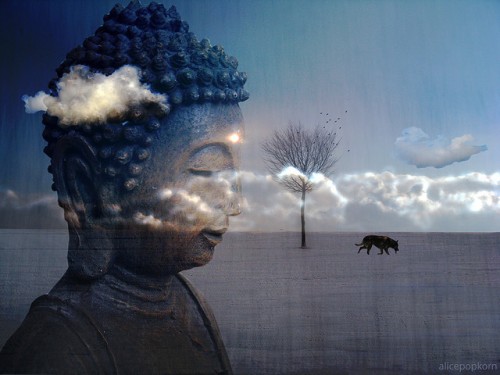Eleditor’s note: Elephant is a diverse community of sixteen million readers and hundreds of writers (you can write too!). We are reader-created. Many blogs here are experience, opinion, and not fact or The One Right Point of View. We welcome all points of view, especially when offered with more sources and less invective, more frankness and less PR. Dislike this Op-Ed or opinion? Share your own take here.
Are you ready for initiation?
The significance of initiation—or spiritual empowerment—is often overlooked in today’s Yoga culture.
Initiation is the sacred act in which an individual is given their initial experience of a means to realizing some truth. That means may be anyone of many practical yogic techniques, known as kriyas, and the truth is a realization of the eternal and infinite One.
Because this truth is beyond name and form, it cannot be communicated through words. It can be experienced. For this one needs to learn all the tools to refine the techniques from a teacher who can share his or her own living experience of them. It is then that the techniques become a vehicle to realize the truth in oneself.
Under the right conditions, initiation will awaken a higher state of consciousness in the aspirant. Once this awakening occurs, the techniques provide a means to maintaining a higher state of consciousness.
Yoga is a path of Self-realization, that which is beyond names and form, beyond the body-mind-emotions-personality. After glimpsing it, however, we must feed the fire of aspiration and transformation to remain in it. The soul or self might be difficult to conceptualize but can be experienced. For this experience you need to uncover the subtle methods to refine yoga techniques.
Most practitioners cannot discover these methods alone; the help of a teacher is required.
During an initiation there is a transmission of energy and consciousness between the initiator and the recipient. The vehicle for this transmission may be a mantra, or touch, through devout chanting, a meditation, a visualization or breathing technique.
What is transmitted is not mere knowledge; if it was only knowledge, a book or an audio visual recording would be sufficient to convey it. It requires a living human being capable of transmitting a higher state of consciousness. That is why mantras cannot be learned from books or audio recordings.
Mantras are sound vehicles of conscious-energy whose purpose is to raise one’s consciousness to a higher level. Mantra diksha or empowerment is one of the most common forms of initiation. When initiation involves touch, the initiator enters into a higher state of consciousness and transmits a sublime conscious-energy through the hands into the recipient.
This awakens a higher consciousness within the recipient.
The transmission may not be effective if the student is non-receptive, full of questions, doubts or distractions. So the initiator attempts to prepare the recipient beforehand with various exercises and austerities pertaining to diet and extended periods of silence, as well as control of the physical and social environment so that these potential disturbances are minimized.
Like a gardener preparing a seed bed, the initiator prepares the mind of the recipient before planting the bija or “seed syllable” mantras so that they will take root, and with continued care will grow and reproduce their potential states of consciousness. Consequently, the recipient’s consciousness becomes quieted and expands beyond its habitual mental and emotional boundaries.
During the initiation, the initiator takes into himself or herself, in effect, the consciousness of the recipient, and begins to expand it beyond its habitual mental and vital boundaries. There is a kind of melting of ordinary mental and vital boundaries, between the initiator and the recipient, and this greatly facilitates movement of consciousness to a higher plane.
By so doing, the initiator reveals to the recipient the existence of his or her own soul, the light and vibration of a higher Self, which until then, had remained veiled by the movements of the mind in most persons. The recipient glimpses their potential consciousness and power. This is what is meant by the awakening of the kundalini of the disciple. The recipient feels deep calmness, may exhibit tears of love, a shift in breathing, bright light and or spiralling vibration within the body.
It is most often not done in a dramatic way. For most, it is experienced as subtle shifts of consciousness, a new way of seeing the world, which happens gradually over a period of time. Slow and progressive life changes occur: greater creativity, insights, wisdom, empathy and compassion, health and balance. These may be limited however, upon the ones ability to discern and apply oneself to the task of letting go of the negative habits and tendencies which maintain the egoistic perspective and which are obstacles to transformation.
Preparation of the initiate and the initiator
For the initiation to be effective two things are essential: the preparation of the student or recipient, and the preparation of an initiator who has opened to the Truth of his or her own True Self. The initiator must be able to access the higher state of consciousness, Self-realization, if they are to be capable of transmitting it. The recipient must have acquired some understanding of the path to Self-realization and be aspiring to replace the perspective of the desire filled ego with that of the soul, the witness.
While most spiritual seekers search for a perfect guru, few concern themselves with their own preparation. It is perhaps a fault of human nature, to seek someone who will “do it for us,” who will wave a magic wand and give Self-realization or God-realization. While the guru may point you in the right direction, the seeker must himself commit himself to following those directions. While the seeker may be intellectually committed to following these, all too often, human nature causes one to waver in distraction, doubt or desire.
So, even if the perfect teacher is found, if the qualities of faith, perseverance, sincerity and patience are not cultivated, the initiation may be like sowing seeds on a concrete sidewalk.
Traditionally, for this reason, initiation was restricted to only those who had prepared themselves, sometimes for years in advance. While the first initiations may be made available to a large number of aspirants, only those who had cultivated the qualities of a disciple attain results from them. As Jesus said, “many are called, but few are chosen.”
Cultivating aspiration
You prepare yourself by cultivating aspiration to find the true purpose of life, by committing yourself towards that purpose, and by purifying yourself of all that resists. Sri Aurobindo defines aspiration as “a spiritual enthusiasm, the height and ardor of the soul’s seeking…an upward movement of our consciousness through the psychic part of our being towards all that is good, pure and beautiful.” The Mother described it as: “an inner enthusiasm towards the New, the Unknown, the Perfection…a yearning, a longing for the contact with the Divine Force, divine Harmony, divine Love…an inner flame, a need for the light.”
It must not be confused with desires, which are manifestations of the ego. The ego seeks to be separate, special, superior, and it manifests desires to strengthen its specialness. A genuine aspiration is just the opposite of this. It is intensely aware of the insufficiencies and imperfections of the ego-bound existence; hence it tries to come out of this sordid prison house.
Each of its movements is directed not to the ego-centre, but away from it.
Aspiration includes recognizing the causes of your suffering, including ignorance of your true identity as pure consciousness, egoism, attachment and aversion. It includes observing the obstacles born of egoism including anger, pride, fear and lust and the causes of suffering. This stage may continue for a very long time. It is most difficult to remain committed to a discipline for years when you don’t attain the results your ego may desire or expect. Typically, as a devotee, you hop from one teacher to another, listening, imitating, watching, and experimenting a little, like a comparison shopper.
Becoming a disciple
At the end of that stage, you become a disciple. You become committed to the practice of the teacher’s prescribed spiritual discipline. Attainment from any spiritual discipline requires persistent effort over an extended period. You need to have faith in the efficacy of the practice, perseverance, the support of a teacher, and divine grace.
If the teacher is authentic, he or she will always be ready to respond to the students request or to find someone who can. And divine grace is always available to one who is open to it. What is problematic is acquiring faith and perseverance. The teacher can give understanding of the techniques, how to do them properly and how they transform the student and will instigate the process through initiation and provide inspiration and encouragement, but the student must consistently apply him/her self with confidence and faith.
Attainment of any spiritual discipline requires persistent effort over an extended time. Once we have darshan or contact with the inner guru, guide or preceptor, our path will be and will remain clear.
Can one effectively learn the kriyas or techniques without initiation? Understanding what has been discussed above, the answer is: it depends on the qualities and habits of the individual, but it is highly unlikely.
It would require Divine Grace and unrelenting faith. There is an essential sacred transmission of consciousness and energy, which empowers the techniques. That is why initiatory traditions have managed to pass the direct experience of truth from one generation to the next so effectively. Their strength lies in the power and the consciousness of those who have done the practices intensely and so realized their truth.
Yoga is so much more than a bunch of techniques to shape the body and reduce stress. It has the potential to free one from suffering, to bring Self-realization, and to transform human nature.
*
Resources which offer initiation in the authentic traditions of Yoga and Tantra:
Babaji’s Kriya Yoga Order of Acharyas
The Self Realization Fellowship
Healthy Happy Holy Organization
For further reading:
Tirumandiram: www.tirumandiram.net ISBN 978-1-895383-61-4
The Yoga of Boganathar, volumes 1 & 2, by Dr. T.N. Ganapathy, Babaji’s Kriya Yoga and Publications, Quebec, Canada ISBN 978-1-895383-19-5, and 978-1-895383-26-3
Inner Tantric Yoga, by Dr. David Frawley, Lotus Press ISBN 978-0-9406-7650-3
The Autobiography of a Yogi, by Paramahansa Yogananda, Self Realization Fellowship, www.yogananda-srf.org.
The Way of the Pilgrim and The Pilgrim Continues his Way, anonymous author, is the chronicle of an anonymous nineteenth century Russian Christian’s travels and spiritual inquiries. Eye-opening and extraordinary, The Way of a Pilgrim offers a one-of-a-kind portrait of the traditions and interior life of Russian Orthodox spirituality and practice.
Tantra: the Path of Ecstasy, by Georg Feuerstein, Shamballa Publications, ISBN 978-1-570623-04-5
The Wisdom of Jesus and the Yoga Siddhas, by Marshall Govindan, Babaji’s Kriya Yoga and Publications, ISBN 978-1-895383-43-0
Sri Aurobindo or the Adventure in Consciousness, by Satprem
**
Marshall Govindan is the author of Babaji and the 18 Siddha Kriya Yoga Tradition, now published in 17 languages, the first international English translation of Thirumandiram: a Classic of Yoga and Tantra, Kriya Yoga Sutras of Patanjali and the Siddhas, The Wisdom of Jesus and the Yoga Siddhas, and Kriya Yoga Insights Along the Path. Since the year 2000, he has sponsored and directed a team of six scholars in India in a large scale research project which has preserved, transcribed, translated and published of the writing of the Tamil Yoga Siddhas of south India in eleven volumes.
Relephant Read:
The Experience of Initiation by The Dalai Lama.
My Love-affair With Tantra (And It’s not Just About Sex)
Author: Marshall Govindan
Editor: Renée Picard
Image: Alice Popkorn at Flickr



Read 1 comment and reply